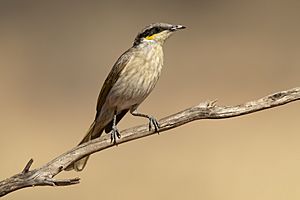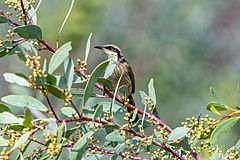Singing honeyeater facts for kids
The singing honeyeater (Gavicalis virescens) is a small bird that lives in Australia. It belongs to the honeyeater family, called Meliphagidae. These birds are quite common. You can find them in many places across Australia, especially west of the Great Dividing Range. They live in areas with shrubs, forests, and along the coast, even on islands off Western Australia. You won't find them in other countries.
Quick facts for kids Singing honeyeater |
|
|---|---|
 |
|
| Conservation status | |
| Scientific classification | |
| Genus: |
Gavicalis
|
| Species: |
virescens
|
| Synonyms | |
|
Lichenostomus virescens |
|
Contents
About Its Name
Scientists give every animal a special two-part name. The singing honeyeater was first named Meliphaga virescens lipferti. Later, it was put into a group called Lichenostomus.
But in 2011, scientists studied its family tree using special tests. They found that it fit better in a different group, so they moved it to the genus Gavicalis.
The name Gavicalis is a mix-up of the letters from a similar bird group, Caligavis. The second part of its name, virescens, comes from a Latin word meaning 'greenish'.
What It Looks Like
Singing honeyeaters are about 17 to 22 centimeters (6.7 to 8.7 inches) long. They are mostly grey-brown. Their tail and wings have a mix of olive-green and yellow colors.
They have a wide, black stripe that goes from behind their beak all the way to the back of their head. Right below this black stripe, there's a yellow streak that starts at their eye.
The sounds they make can be different. Some songs are scratchy, while others are very musical. Their songs can even change depending on where they live.
Some other honeyeaters look very similar to the singing honeyeater. They might have similar colors, features, or even voices. Because of this, it can be tricky to tell them apart. A good bird guide with clear pictures can help you identify them correctly.
What It Eats
Singing honeyeaters eat many different things. They drink nectar from flowers. They also eat small insects, fruits, grubs, and berries. This means they are omnivores, eating both plants and animals.
Reproduction and Family Life
Singing honeyeaters usually breed between July and February. They can form long-lasting pairs with their partners. When they are breeding, they can become very protective and act aggressively.
Their nest is shaped like a cup. They build it using grass, plant stems, and even spider webs. The eggs they lay are light cream-brown with some darker spots.
Singing honeyeaters live in family groups. They will attack larger animals if they feel threatened. They also attack if other animals enter their territory. They are known to team up and attack intruders together. This shows they are very community-minded birds.
They often hang out with other bird species. These can include the brown honeyeater and the red wattlebird. However, singing honeyeaters are different from many birds in one way. They can't always talk to other singing honeyeaters that live far away.
A study by M.C. Baker in 1996 showed this. Birds on the mainland did not respond to the songs of singing honeyeaters from an island off Australia's west coast. The study found that the island birds' songs were shorter. They also had fewer types of songs and syllables.
Gallery
- "Singing honeyeater." birdphotos . 15 Dec 2006 [1]
See also
 In Spanish: Mielero cantarín para niños
In Spanish: Mielero cantarín para niños




